The notion that a child has a right to imaginative play is relatively recent and has been
generally accepted only within the last 120 years. The concept is usually attributed to
educator and doctor Maria Montessori, who favored independant play, rather than rote
learning in groups. In fact, the wide availability of toys for children
other than the children of the wealthy didn't become a reality until after the American
Civil War. That explains why construction toys weren't a major retail
item before 1892, when they began to be advertised in the Marshall Fields catalog.
Construction toys were right for their times. The industrial revolution had created
a population intellectually and emotionally involved with mechanics and powered
machinery of all sorts, capturing the minds of children and adults both (much as
computers seem to be doing today). Metal construction sets such as Erector and Meccano,
first produced near the turn of the 20th century, were creative playthings that
parents could delight in giving their children.
Probably the most influential construction toys were the Erector sets of A.C. Gilbert,
first introduced in 1913, and their English made competitor, Meccano.
However, many other construction toys have been popular, such as
Lincoln Logs (invented in 1920 by John Lloyd Wright, the son of the famous architect,
Frank Lloyd Wright), the German-made Anchor artificial stone block kits, Tinker Toys
and Lego sets. And, of course, there have been many manufacturers of sets of wood
blocks cut into shapes suitable for structural model building.
A. C. Gilbert's Erector sets and Frank Hornby's Meccano sets were designed to teach
the principles of mechanics and physics at a time in American history when most
adults had faith in a world of endless technological progress. In addition,
construction toys of wood, mortar and plastic-such as Lincoln Logs, Anchor Blocks,
and Lego - taught principles of architecture.
Alfred Carlton Gilbert and the Erector set.
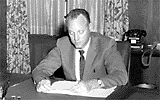 A.C. Gilbert (1884-1962) was a multi-faceted individual. Born in 1884 in Salem,
Oregon, he had two great interests in life: athletics and magic. His athletic career began at Pacific University in Portland, Oregon, where he broke the existing pole vaulting
record with a jump of 11 feet 7 inches. He transferred to Yale University, majoring in medicine. After being
named to the 1908 US Summer Olympic pole vaulting team, he won the gold medal in England that year. That
same year he married Mary Thompson, whom he had met at Pacific University. They had three children: two
girls and a boy.
A.C. Gilbert (1884-1962) was a multi-faceted individual. Born in 1884 in Salem,
Oregon, he had two great interests in life: athletics and magic. His athletic career began at Pacific University in Portland, Oregon, where he broke the existing pole vaulting
record with a jump of 11 feet 7 inches. He transferred to Yale University, majoring in medicine. After being
named to the 1908 US Summer Olympic pole vaulting team, he won the gold medal in England that year. That
same year he married Mary Thompson, whom he had met at Pacific University. They had three children: two
girls and a boy.
While at Yale, Gilbert earned part of his tuition money by performing sleight-of-hand
tricks. He became so proficient that with a partner, mechanic John Petrie, he started
a brand of games and toys based on magic, called "Mysto Magic." The first boxes sold
for $5 with magic lessons by Gilbert included in the price.
Gilbert completed his medical degree in 1909, but rather than practice medicine, he
decided to pursue his fledgling magic business. Although disappointed, his father
lent him $5,000 to build a small plant in Connecticut. Financial success was almost
immediate and by the third year, the majority of big department stores in the
country was ordering the magic sets.
During the time he was marketing his magic sets, Gilbert was busy at work perfecting
a perforated steel construction toy with which children could make their own toys.
He named the toy "Erector". The Erector set, conceived in 1911 and first sold in 1913, was introduced as the
"Mysto Erector Structural Steel Builder". Mysto was renamed as the A.C. Gilbert
Company in 1916, but the Mysto Magic name remained attached to magic sets sold by
the company.
Erector sets were introduced to the toy world in the summer of 1913 at the Toy Fair
held in New York City. Erector was an instant success for two reasons. First,
Erector offered a motor, which added the highly appealing element of motion to
their models. Second, the Erector girders, the most distinguishing element in
the Erector system, were much more realistic than anything the competition offered
at this time. Sets were available in nine different sizes, priced from 50 cents
to $25. Each set came with an instruction manual illustrating the models that
could be built; all these models were designed by Gilbert.
Of all A. C. Gilbert's considerable business abilities, he was best at promotion. The 1913 advertising campaign
was national in scope, with ads appearing in many of the popular magazines of the day. Anyone who wrote in
would receive a free book, which was actually a catalog. His most brilliant promotion was the announcement of
the first Erector contest. The overwhelming response allowed him to expand the number of models in the 1914
catalog to over 300, and to claim: "Erector builds the most models."
In 1914 two changes were instituted. The first involved the redesigning of the Erector girders. The old girders
had been flanged: they had an angle bent on both edges of the strip. A groove was added on each edge which
greatly enhanced strength and usefulness. Secondly, the electric motor was factory assembled. Earlier, the
motor was packed in pieces and had to be constructed, making it too complicated for most children to put
together.
One of the highlights of 1915 was the gold medal Erector won at the Panama Pacific Exposition in San
Francisco, for its technical and scientific advances. This same year found the first train made from Erector. It
was composed of a steam engine, a tender, a gondola, and a caboose; no single set contained enough parts
to build the whole train at the same time.
In 1915, Gilbert started producing small fans to keep his workforce operating all year round, since the toy
business is highly seasonal. Profits for the year exceeded $120,000. In 1916 when sales surpassed $1 million,
Gilbert changed the name of the company from "Mysto" to "The A. C. Gilbert Company."
The original sets ranged from simple to complex, and could be had for prices ranging from 50 cents to $25.
Eight sets were available, ranging from the simple #1 set to the complex #8 set.
Erector sets included pulleys, gears, and a number of 1" wide strips
with the edges folded over, permitting 4 strips to be assembled using
2 screws to create a strong square box girder.
The changes that occurred from one year to the next in the company were generally
modest and orderly. 1920 was the exception. That year saw the creation of No. 10,
perhaps the most coveted and highly valued of all Erector sets. At $35 it cost the
most of all sets sold that year, built the most models (410), and included a new
heavy-duty motor. It was produced through 1932. In 1924, Gilbert changed to 1/2"
wide strips to permit the assembly of more complex and detailed objects.
In 1929 Gilbert bought out Meccano's factory in New Jersey. Meccano of England was
Erector's closest rival, although Erector held the largest U. S. market share from
its inception. Gilbert now manufactured both The New American Meccano
(Gilbert-Meccano sets) and the Erector line.
The Great Depression affected Gilbert's profits, just as it did with most companies,
and in 1932 the company posted a net loss of over $26,000. 1933 saw the transition
from wood to metal boxes. Rubber tires, introduced in 1926, were supplied
through 1934. The introduction of skyscraper parts was done in 1935, the only year
they were offered as part of a set.
More than any other model, though, the Ferris Wheel of 1935 has come to symbolize
the epitome of Erector sets. The Parachute Jump Ride was unveiled in 1940. This is
one of the most significant models in modern Erector history. Inspired by the
Parachute Jump Ride at the 1939 World's Fair in New York, this model stood
5 feet high.
By 1941, the A.C. Gilbert Company, located in New Haven, CT, was the largest
toy manufacturer in the world. Also in 1941, Gilbert opened the A. C. Gilbert Hall
of Science in New York, arguably one of the earliest approachable science and
technology museums. It promoted learning at least as much as it promoted Gilbert's
toys.
There were no metal Erector Sets produced throughout World War II, as steel was
rationed. During this time sets were made of wood.
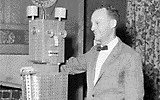 The simple #4 set of 1916 could be used to build a wagon, but by 1948 the most
complex Erector set (#12 1/2, with multiple electric motors, was produced until 1962) could build a robot that
incorporated an electric motor and could actually walk. Gilbert nurtured his market by sponsoring
contests for the most imaginative designs and by including lavishly illustrated and
detailed manuals with his Erector construction sets. Erector sets were heavily
advertised from their inception in 1913.
The simple #4 set of 1916 could be used to build a wagon, but by 1948 the most
complex Erector set (#12 1/2, with multiple electric motors, was produced until 1962) could build a robot that
incorporated an electric motor and could actually walk. Gilbert nurtured his market by sponsoring
contests for the most imaginative designs and by including lavishly illustrated and
detailed manuals with his Erector construction sets. Erector sets were heavily
advertised from their inception in 1913.
Erector sets distinguished themselves by thir incorporation of small battery powered electric motors.
Originally added as something of an afterthought, the motors became a popular feature, allowing
young builders to add the action they craved to otherwise static models. And as a byproduct, the
A.C. Gilbert Company became one of the largest manufacturers of fractional horsepower motors. The
battery powered DC motors were eventually replaced by more powerful AC motors. Young experimenters
could learn something about product safety in a very realistic (sometimes painful) manner. Erector
set motors were often used to construct prototype "real products", such as the equipment designed in
1949 for open heart bypass surgery by Dr. William Sewell of Yale.
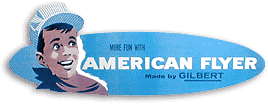 The A.C. Gilbert company acquired the American Flyer Train Company in 1937.
After the war, it became the major supplier of S gauge electric trains from 1946 to
1966, and the company did a considerable amount of joint promotion of the trains and Erector sets as adjuncts to each other. Of
course, nothing prevented a Lionel train owner from building bridges and other structures with
Erector sets: Many did, and Gilbert happily received their money. The company also sold chemistry sets, a simple
atomic energy laboratory, and a glass blowing kit.
The A.C. Gilbert company acquired the American Flyer Train Company in 1937.
After the war, it became the major supplier of S gauge electric trains from 1946 to
1966, and the company did a considerable amount of joint promotion of the trains and Erector sets as adjuncts to each other. Of
course, nothing prevented a Lionel train owner from building bridges and other structures with
Erector sets: Many did, and Gilbert happily received their money. The company also sold chemistry sets, a simple
atomic energy laboratory, and a glass blowing kit.
After World War II, even though Gilbert didn't realize it, the company was almost
assured of success for several years because of the Baby Boom. But the onset of the
decline of Erector could be seen as early as 1950. Not one new model was added for
eight years. Additionally, there was a failure to modernize the available models in
the catalog. Besides a reduction in the quality of the toy, there was a change in
the lifestyle of the Erector customers. Other products, such as Tinker Toys, Lincoln
Logs, and Legos, became more popular. Gilbert himself retired in 1956 and died in
1962. Beginning in 1963, the Erector system completely changed and became more
Meccano-like.
A. C. Gilbert's Erector Company went out of business in 1966. The A.C. Gilbert
Company, which had been run by his son since the mid 1950s,
continued on for a few more years, but in 1962 had to sell a majority interest
to the Wrather Company. Despite bringing in new managment, the company was unable
to halt its decline, and was subsequently sold in 1967 to Gabriel
Industries of Lancaster, Pennsylvania. Gabriel established the Gilbert Division,
later known as Gilbert Industries, to manufacture Erector sets. The new operation
was successful for a few years, but went into decline in 1976. Gabriel, in turn,
was sold to communications giant CBS and CBS Toys in 1981. In 1984, Gabriel was
resold to Ideal Toys. From 1984 to 1987 Ideal Inc. of Oregon held the rights to
Erector, though production ceased in 1986. Meccano eventually purchased the rights to
the Erector name and designs: Currently, Meccano (originally English, but now French)
is credited with saving Erector and sales are second only to popular Lego
construction toys.
During his lifetime, A.C. Gilbert was awarded over 150 patents. It is unfair to
characterize him as a toymaker, for his creations were actually an effective tool
for learning scientific and engineering principles. While many of his creations
would probably run afoul of product safety regulations today, Maria Montessori would
have applauded his efforts.
Frank Hornby and Meccano
Englishman Frank Hornby (1863-1936) was born in Liverpool in 1863. His mother was a
homemaker, his father a provision dealer. Although he loved to read, Frank was a
dreamer and did not like school; he stayed until the age of sixteen, at which time
he started working in his father's business. In 1887, he married, and that same year
his father died, forcing Frank to seek a bookkeeping job with a meat importing
business. He started working for David Elliott, who soon became his business partner.
Hornby stayed at this company almost 21 years, until 1908, a year after he started
Meccano. He and his wife had 3 children, 2 boys and much later, a girl (who died
in her teens). His mother and his wife are credited with encouraging and supporting
Frank in all his endeavors.
As Hornby's boys grew older, they showed interest in mechanical toys. Frank, although
having no formal training in engineering or mechanics, started to invent toys for
them. With only a small workshop and very few tools, his greatest asset was his
determination. He began making construction toys, with no interchangeable parts, from
sheet metal cut by hand.
Eventually he conceived the basic construction element:
a flat metal strip, 1/2 inch wide and perforated at 1/2 inch intervals. Starting
with a sheet of copper, he cut strips of various lengths and drilled holes in them.
How to hold the strips together? Nuts and bolts were the obvious answer; he had to
laboriously make them by hand. He was beginning to realize he had invented a
versatile children's construction toy. As he was interested in photography, he
recorded some of his early models. Hornby reputedly had to borrow the patent fees
of five pounds from Elliott. He received a patent in 1901 for "Meccanics Made
Easy", the forerunner of the Meccano set.
His first sets were called Mechanics Made Easy. These sets contained 16 pieces and cost the equivalent of
exactly half the weekly wage of a laborer in the 1901-1902 period. It is a wonder
that Hornby sold any sets at all, but by 1903 he had sold 2,000 boxes. Early sets
contained about 15 pieces of tin-plated metal strips and plates fastened together
with nuts and bolts. The sets grew in complexity over the years
as gears and other elements were added.
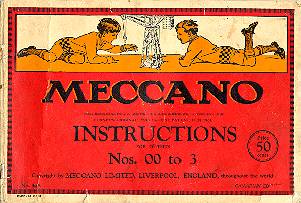 In 1907, after the company showed a profit, Hornby decided to manufacture his own product. The name
Meccano was coined but it is not known exactly by whom. The name of the firm was changed to "Meccano" in 1908 when
Hornby bought out his partner. Hornby did not change much about his product for
several years, except to replace the tin boxes with cardboard cartons. Early Meccano
models used plates, strips, and wheels to produce little more than three-dimensional
sketches of objects. Components were often used merely to represent something they
looked liked, but the engineering potentialities of the system were soon recognized.
In the United States, prior to 1910 Meccano was sold by an inporter, The Embossing Co.
of Albany, NY,
In 1907, after the company showed a profit, Hornby decided to manufacture his own product. The name
Meccano was coined but it is not known exactly by whom. The name of the firm was changed to "Meccano" in 1908 when
Hornby bought out his partner. Hornby did not change much about his product for
several years, except to replace the tin boxes with cardboard cartons. Early Meccano
models used plates, strips, and wheels to produce little more than three-dimensional
sketches of objects. Components were often used merely to represent something they
looked liked, but the engineering potentialities of the system were soon recognized.
In the United States, prior to 1910 Meccano was sold by an inporter, The Embossing Co.
of Albany, NY,
In 1912, Meccano introduced a new type of spring motor made by the
German toy company Marklin, which produced supreme clockwork units in their
model trains and other toys. An even larger factory was constructed
in Liverpool in 1914 as the company continued to grow, establishing
factories in France, Germany, Spain and Argentina. The Liverpool factory
operated for the next 66 years. Like Gilbert, Meccano promoted its
products heavily through contests and advertising. The two companies
were fierce competitors through the first half of the 20th century.
By 1913, demand was so great for Meccano that Hornby could be selective
in appointing dealers by franchise. During the first World War little new was
manufactured since the factory was making munitions. In 1920 the Meccano Inventor's
Outfit recognized that it was more than a toy by including miniature engineering
components such as bevel gears, threaded cranks, rack strips, gear wheels and pinions.
One of the first of the "properly engineered" models was the Motor Car Chassis of
1921. It was driven by one of the Meccano electric motors and had a working clutch,
three-speed and reverse gearbox, differential gear, both hand and foot brakes and
leaf springs for the suspension.
Meccano parts first came out in colors in 1926. The September issue of Meccano
Magazine showed a limited range of parts in pea-pod green and bright red. Most
strips and girders remained nickel-plated. (Meccano Magazine, started by Hornby
in 1916, contained many advertisements for Meccano as well as articles of
general and engineering interest.)
A manufacturing venture in the U.S. established about 1922 in Elizabeth, NJ
was unable to compete with the A.C. Gilbert Company and was sold to A. C. Gilbert
in 1929. Despite this setback, Hornby was elected to Parliament in 1931.
He died in 1936.
Over the years, Meccano produced numerous specialized kits to produce
airplanes, cranes, military equipment, robots and various vehicles.
Hornby brand O gauge trains were also produced beginning in 1925 and became a
leading brand in England. Meccano also had a marketing relationship with Lionel Corp,
which included Meccano products in some of its electric train catalogs.
In 1934 Meccano introduced a construction toy for younger children:
The Dinky Builder, a system of rapid and simple assembly composed of rectangular
or triangular shaped parts. The parts were enameled in jade green
and salmon pink in the hope of also appealing to young girls, a hitherto
unemphasized market. However, the company started to decline in profitability
after World War II and was taken over by the Lines Brothers in 1964.
Meccano Ltd. entered bankruptcy in 1979 and became part of the Airfix Group:
The factory ceased operating in 1980, but Meccano's overseas subsidiaries continued
to make Meccano sets. In 1981, Airfix went into liquidation. Meccano
and Dinky Toy was purchased by the General Mills Toy Group (USA), owners of
Miro-Meccano Company, Paris, France.
Miro-Meccano (which in 1990 purchased rights to the Erector name in the U.S.) and
Exacto Ltd. of Argentina continued to produce the Meccano product line. The French firm
was reorganized as Meccano S/A, now located in Calais.
Meccano S/A was purchased by Nikko, a Japanese manufacturer of radio controlled toys,
in May, 2000.
Charles Pajeau and Tinkertoy
Tinkertoy construction sets were invented in 1913 by Charles Pajeau, a
stonemason from Evanston, Illinois. Inspired by watching children play
with pencils, sticks and empty spools of thread, Pajeau developed
several basic wooden parts which children could assemble in three
dimensions in many different ways. Partnering with Robert Petit, he
established the Toy Tinkers Company in 1913 to commercialize his ideas.
Their product was the "Thousand Wonder Toy", later to be renamed as
Tinker Toys. Pajeau promoted his invention by setting up models in
drug stores and hiring people to build models in retail store front
windows. Tinker Toys retained wood and paper components for most of
its history. An all plastic version was introduced in 1992, displacing
the wooden versions.
Tinkertoy is currently marketed by Playskool, a unit of Hasbro,Inc.
Lego
Lego is a Danish invention, using interlocking bricks and other shapes to produce
models of just about anything. It is one of the world's all-time most popular toys,
inspiring clubs, web sites and contests. The name derives from the Danish "Leg Godt",
meaning "play well". In Latin, it means "to put together", also appropriate.
 Ole Kirk Christiansen (1891 - 1958), credited as the inventor of Lego, started his toy
company in Billund, a small town in Denmark in 1932. He had originally been trained
as a carpenter and joiner, and was skilled in the fabrication of wooden items.
Originally the company produced wooden toys, stepladders and ironing boards.
The Lego name was adopted in 1934.
Ole Kirk Christiansen (1891 - 1958), credited as the inventor of Lego, started his toy
company in Billund, a small town in Denmark in 1932. He had originally been trained
as a carpenter and joiner, and was skilled in the fabrication of wooden items.
Originally the company produced wooden toys, stepladders and ironing boards.
The Lego name was adopted in 1934.
Even in the middle of the German occupation of Denmark during WW II, the 12 employees
of the company continued production, until the factory burned in 1942. Undaunted, the
company reconstructed its plant and restarted production.
The migration towards plastic began in 1947, when Lego acquired one of the first
plastic injection-moulding machines in Denmark. At that time, it also became a
specialized toy manufacturer, dropping non-toy items from its product line.
An interlocking brick construction toy (Automatic Binding Bricks) was first
introduced in Denmark in 1949. This was a predecessor of the current design,
which was first produced in 1958. Lego produced about 200 varieties of
plastic and wood toys in that period, but by 1951, over half of the items produced
were plastic, usually made of cellulose acetate. The shift to plastic was completed
in 1960 after a fire destroyed Lego's stock of wood. 1951 also saw "Automatic Binding Bricks"
renamed as "Lego Mursten" -- "Lego Bricks", in English. In 1955, 28 different Lego sets
and eight vehicle kits were introduced as the "Lego System of Play".
 The 1958 version of the interlocking brick included eight stubby cylinders and
eight matching studs molded into the surface, allowing the bricks to be firmly attached to one another. Bricks became available in a
variety of sizes, shapes and colors. Sloping roof tiles also appeared in 1958. In
1963,ABS plastic (acrylonitrile butadiene styrene) replaced cellulose acetate as a molding material, providing greater
strength, durability and improved colors. The simplest Lego
construction products, "Duplo" bricks, designed for younger children, were first sold in
Denmark in 1967, and internationally since 1969. They were immensely popular from
their inception. The variety of Lego bricks has been expanded and enhanced to the
point where bricks in "Mindstorm" sets now include microchips, permitting
construction of automated devices controllable over the internet. The current list
of sets also includes "Fabuland", "Lego Basic", LegoLand", LEGO Technic Sets and
a variety of kits to produce boats, trains and other objects.
The 1958 version of the interlocking brick included eight stubby cylinders and
eight matching studs molded into the surface, allowing the bricks to be firmly attached to one another. Bricks became available in a
variety of sizes, shapes and colors. Sloping roof tiles also appeared in 1958. In
1963,ABS plastic (acrylonitrile butadiene styrene) replaced cellulose acetate as a molding material, providing greater
strength, durability and improved colors. The simplest Lego
construction products, "Duplo" bricks, designed for younger children, were first sold in
Denmark in 1967, and internationally since 1969. They were immensely popular from
their inception. The variety of Lego bricks has been expanded and enhanced to the
point where bricks in "Mindstorm" sets now include microchips, permitting
construction of automated devices controllable over the internet. The current list
of sets also includes "Fabuland", "Lego Basic", LegoLand", LEGO Technic Sets and
a variety of kits to produce boats, trains and other objects.
The Lego Company now markets in 138 countries, and estimates that over 300,000,000
children have built something with Lego bricks. Specialized Lego sets also appeal
to adults, who use them for recreation, concept modeling, therapy and education.
The management of the company has stayed in the family. Ole Kirk Christiansen was
succeeded by his son, Godtfred Kirk Christiansen, upon his death in 1958. His
grandson, Kjeld Kirk Kristiansen, currently manages the company, which employs
over 10,000 people and operates in 30 countries.
Exhibit Companion
 (left) The largest Erector sets available in 1940 (on the left) and in 1957 (on the right).
The 1940 set in the blue box has never been unpacked and played with. It contains an
American Flyer locomotive and a circle of track. Buyers built the tender, cars and
accessories from Erector set parts.
(left) The largest Erector sets available in 1940 (on the left) and in 1957 (on the right).
The 1940 set in the blue box has never been unpacked and played with. It contains an
American Flyer locomotive and a circle of track. Buyers built the tender, cars and
accessories from Erector set parts.
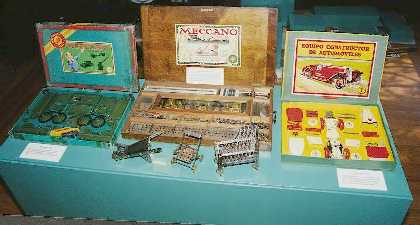 (right) Unusual Meccano sets, made in Liverpool, England (left to right):
(right) Unusual Meccano sets, made in Liverpool, England (left to right):
- Mechanized Army Outfit, 1939.
- No. 5 set, 1913.
- Automobile Constructor, 1937, Spanish edition.
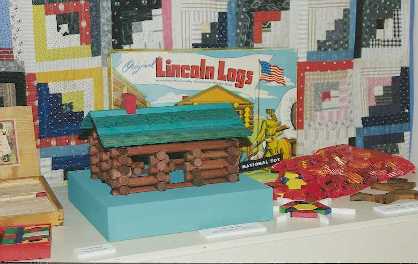 (left) Lincoln Log house, 1930s.
(left) Lincoln Log house, 1930s.
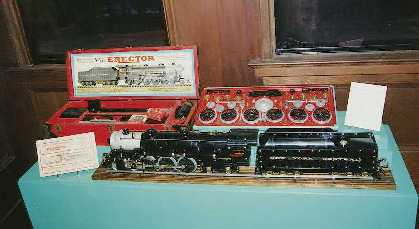 (right) Erector No. 8 1/2 set, 1931, with model of Hudson locomotive and tender.
The set is complete as it came from the factory; The model was built with parts
from another set.
(right) Erector No. 8 1/2 set, 1931, with model of Hudson locomotive and tender.
The set is complete as it came from the factory; The model was built with parts
from another set.
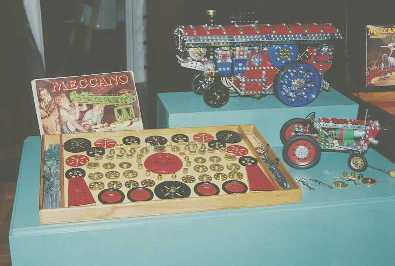 (left) Meccano (Liverpool, England) No. 10 set and models, 1950. The larger model is of a
steam traction engine and the smaller model is of a contemporary tractor. This set
contained 2,750 pieces.
(left) Meccano (Liverpool, England) No. 10 set and models, 1950. The larger model is of a
steam traction engine and the smaller model is of a contemporary tractor. This set
contained 2,750 pieces.
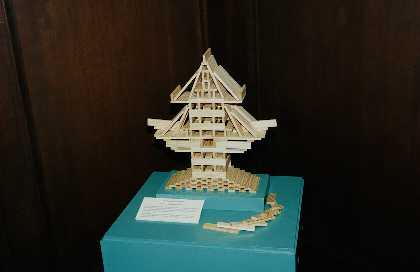
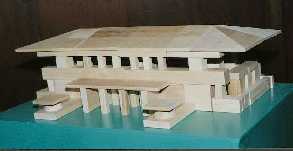 (left) Not all construction toys are classics. Modern versions exist and are popular.
The Kapla construction set illustrated here is somewhat unique in that all of
its wooden beams are the same size.
(left) Not all construction toys are classics. Modern versions exist and are popular.
The Kapla construction set illustrated here is somewhat unique in that all of
its wooden beams are the same size.
(right) Budding architects with a taste for the mid-20th century can emulate Frank Lloyd Wright.
Using the block set shown, they can create model structures in Wright's style.
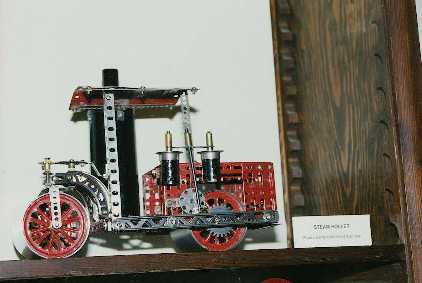
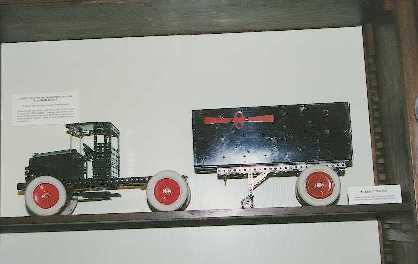 (left) This steam roller model, the Best steam tractor (left, below), and the early big rig (right)
all built from 1928-1932 vintage Erector parts, illustrates the motivation of
children to acquire multiple Erector sets.
(left) This steam roller model, the Best steam tractor (left, below), and the early big rig (right)
all built from 1928-1932 vintage Erector parts, illustrates the motivation of
children to acquire multiple Erector sets.

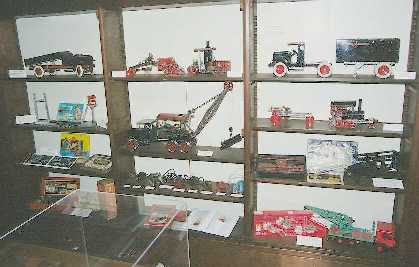 (right) Display of models built with Erector and Marklin (German) metal
construction set parts.
(right) Display of models built with Erector and Marklin (German) metal
construction set parts.
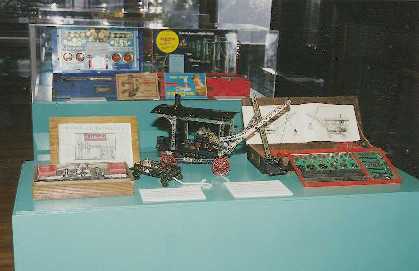 (right) Several Erector sets - Left to right, in foreground:
(right) Several Erector sets - Left to right, in foreground:
- Erector No. 4 set, 1916, with small model of cart.
- Steam shovel, featured model of 1924-1932 No. 7 Erector sets.
- Erector No. 7 set, 1927.
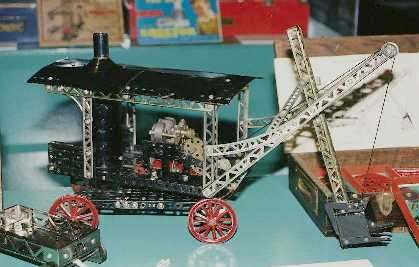 (left) Steam shovel, featured model of 1924-1932 No. 7 Erector sets.
(left) Steam shovel, featured model of 1924-1932 No. 7 Erector sets.
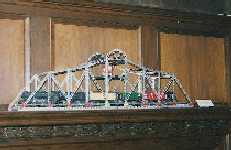 (right) Erector railroad bridge model with Lionel trains. The model was built
mostly from 1950s and 1960s vintage Erector parts; The trains are Lionel "O" gauge
from late 1930s.
(right) Erector railroad bridge model with Lionel trains. The model was built
mostly from 1950s and 1960s vintage Erector parts; The trains are Lionel "O" gauge
from late 1930s.
Did you enjoy this exhibit? Your on-line donation will help us maintain this exhibit and create others. Thanks for your support!
Bibliography
Web Sites
A. C. Gilbert Discovery Village A children's museum in Salem, OR
A.C. Gilbert Historical Society
Canadian Modeling Association for Meccano and Allied Systems
Construction Toys in Motion: 2006 MOAH exhibit
Eli Whitney Museum: A.C. Gilbert
Erector World
International Society of Meccanomen
Lego history page The history of Legos.
M.I.T. Inventor of the Week Archives: A.C. Gilbert
History of Meccano
Meccano and Hornby Trains
Southern California Meccano and Erector Club
Books
Discovering Late Erector 1963-1988, Marshall McKusick, Ashton Press, Iowa City, 1997
Greenberg's Guide to Gilbert Erector Sets (2 vols.) William M. Bean and Al M. Sternagle, Greenberg Publishing
Company, Sykesville, Maryland, 1993
The Man Who Lives in Paradise: Autobiography of A.C. Gilbert A.C. Gilbert & Marshall McClintock, Rinehart, 1954
The Meccano System and the Special Purpose Meccano Sets, Bert Love and Jim Gamble, New Cavendish Books, London, 1985
Credits
Most items exhibited are from the collection of Charlie and Kim Pack. The steam roller, big rig
and steam tractor and some of the other models in the wall case are courtesy of Paul
Jennings. The built-up Hudson locomotive and tender model is courtesy of Clyde Easterly.
Gilbert Family Collection: Photos of A.C. Gilbert
All trademarks, service marks and copyrights are the property of their owners.
Our Special Thanks
The Museum is indebted to many individuals and institutions for this
exhibit. We commend and thank in particular:
Chairperson: Bill Wehrend
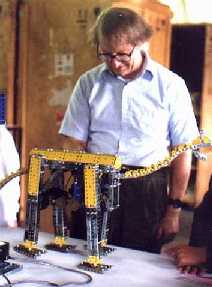
Curator: Charlie Pack
Exhibit designers: Kim Pack, Beryl Self
Committee:
Art Adams
Sue Beaver
Dick Clark
Charlie Gillis
Roberta Gillis
Ralph Igler
Mary Sheila McMahon
Monroe Postman
Beverly Nelson
Theodora Nelson
Bob Wersted
Booklet design by Dick Clark
Telephone Committee and Script Recorder: Miriam Wehrend.
The Museum also thanks the Civic Bank of Commerce for their generous financial support.
 A.C. Gilbert (1884-1962) was a multi-faceted individual. Born in 1884 in Salem,
Oregon, he had two great interests in life: athletics and magic. His athletic career began at Pacific University in Portland, Oregon, where he broke the existing pole vaulting
record with a jump of 11 feet 7 inches. He transferred to Yale University, majoring in medicine. After being
named to the 1908 US Summer Olympic pole vaulting team, he won the gold medal in England that year. That
same year he married Mary Thompson, whom he had met at Pacific University. They had three children: two
girls and a boy.
A.C. Gilbert (1884-1962) was a multi-faceted individual. Born in 1884 in Salem,
Oregon, he had two great interests in life: athletics and magic. His athletic career began at Pacific University in Portland, Oregon, where he broke the existing pole vaulting
record with a jump of 11 feet 7 inches. He transferred to Yale University, majoring in medicine. After being
named to the 1908 US Summer Olympic pole vaulting team, he won the gold medal in England that year. That
same year he married Mary Thompson, whom he had met at Pacific University. They had three children: two
girls and a boy.
 The simple #4 set of 1916 could be used to build a wagon, but by 1948 the most
complex Erector set (#12 1/2, with multiple electric motors, was produced until 1962) could build a robot that
incorporated an electric motor and could actually walk. Gilbert nurtured his market by sponsoring
contests for the most imaginative designs and by including lavishly illustrated and
detailed manuals with his Erector construction sets. Erector sets were heavily
advertised from their inception in 1913.
The simple #4 set of 1916 could be used to build a wagon, but by 1948 the most
complex Erector set (#12 1/2, with multiple electric motors, was produced until 1962) could build a robot that
incorporated an electric motor and could actually walk. Gilbert nurtured his market by sponsoring
contests for the most imaginative designs and by including lavishly illustrated and
detailed manuals with his Erector construction sets. Erector sets were heavily
advertised from their inception in 1913.
 The A.C. Gilbert company acquired the American Flyer Train Company in 1937.
After the war, it became the major supplier of S gauge electric trains from 1946 to
1966, and the company did a considerable amount of joint promotion of the trains and Erector sets as adjuncts to each other. Of
course, nothing prevented a Lionel train owner from building bridges and other structures with
Erector sets: Many did, and Gilbert happily received their money. The company also sold chemistry sets, a simple
atomic energy laboratory, and a glass blowing kit.
The A.C. Gilbert company acquired the American Flyer Train Company in 1937.
After the war, it became the major supplier of S gauge electric trains from 1946 to
1966, and the company did a considerable amount of joint promotion of the trains and Erector sets as adjuncts to each other. Of
course, nothing prevented a Lionel train owner from building bridges and other structures with
Erector sets: Many did, and Gilbert happily received their money. The company also sold chemistry sets, a simple
atomic energy laboratory, and a glass blowing kit.
 In 1907, after the company showed a profit, Hornby decided to manufacture his own product. The name
Meccano was coined but it is not known exactly by whom. The name of the firm was changed to "Meccano" in 1908 when
Hornby bought out his partner. Hornby did not change much about his product for
several years, except to replace the tin boxes with cardboard cartons. Early Meccano
models used plates, strips, and wheels to produce little more than three-dimensional
sketches of objects. Components were often used merely to represent something they
looked liked, but the engineering potentialities of the system were soon recognized.
In the United States, prior to 1910 Meccano was sold by an inporter, The Embossing Co.
of Albany, NY,
In 1907, after the company showed a profit, Hornby decided to manufacture his own product. The name
Meccano was coined but it is not known exactly by whom. The name of the firm was changed to "Meccano" in 1908 when
Hornby bought out his partner. Hornby did not change much about his product for
several years, except to replace the tin boxes with cardboard cartons. Early Meccano
models used plates, strips, and wheels to produce little more than three-dimensional
sketches of objects. Components were often used merely to represent something they
looked liked, but the engineering potentialities of the system were soon recognized.
In the United States, prior to 1910 Meccano was sold by an inporter, The Embossing Co.
of Albany, NY,
 Ole Kirk Christiansen (1891 - 1958), credited as the inventor of Lego, started his toy
company in Billund, a small town in Denmark in 1932. He had originally been trained
as a carpenter and joiner, and was skilled in the fabrication of wooden items.
Originally the company produced wooden toys, stepladders and ironing boards.
The Lego name was adopted in 1934.
Ole Kirk Christiansen (1891 - 1958), credited as the inventor of Lego, started his toy
company in Billund, a small town in Denmark in 1932. He had originally been trained
as a carpenter and joiner, and was skilled in the fabrication of wooden items.
Originally the company produced wooden toys, stepladders and ironing boards.
The Lego name was adopted in 1934.
 The 1958 version of the interlocking brick included eight stubby cylinders and
eight matching studs molded into the surface, allowing the bricks to be firmly attached to one another. Bricks became available in a
variety of sizes, shapes and colors. Sloping roof tiles also appeared in 1958. In
1963,ABS plastic (acrylonitrile butadiene styrene) replaced cellulose acetate as a molding material, providing greater
strength, durability and improved colors. The simplest Lego
construction products, "Duplo" bricks, designed for younger children, were first sold in
Denmark in 1967, and internationally since 1969. They were immensely popular from
their inception. The variety of Lego bricks has been expanded and enhanced to the
point where bricks in "Mindstorm" sets now include microchips, permitting
construction of automated devices controllable over the internet. The current list
of sets also includes "Fabuland", "Lego Basic", LegoLand", LEGO Technic Sets and
a variety of kits to produce boats, trains and other objects.
The 1958 version of the interlocking brick included eight stubby cylinders and
eight matching studs molded into the surface, allowing the bricks to be firmly attached to one another. Bricks became available in a
variety of sizes, shapes and colors. Sloping roof tiles also appeared in 1958. In
1963,ABS plastic (acrylonitrile butadiene styrene) replaced cellulose acetate as a molding material, providing greater
strength, durability and improved colors. The simplest Lego
construction products, "Duplo" bricks, designed for younger children, were first sold in
Denmark in 1967, and internationally since 1969. They were immensely popular from
their inception. The variety of Lego bricks has been expanded and enhanced to the
point where bricks in "Mindstorm" sets now include microchips, permitting
construction of automated devices controllable over the internet. The current list
of sets also includes "Fabuland", "Lego Basic", LegoLand", LEGO Technic Sets and
a variety of kits to produce boats, trains and other objects.
 (left) The largest Erector sets available in 1940 (on the left) and in 1957 (on the right).
The 1940 set in the blue box has never been unpacked and played with. It contains an
American Flyer locomotive and a circle of track. Buyers built the tender, cars and
accessories from Erector set parts.
(left) The largest Erector sets available in 1940 (on the left) and in 1957 (on the right).
The 1940 set in the blue box has never been unpacked and played with. It contains an
American Flyer locomotive and a circle of track. Buyers built the tender, cars and
accessories from Erector set parts.
 (right) Unusual Meccano sets, made in Liverpool, England (left to right):
(right) Unusual Meccano sets, made in Liverpool, England (left to right):
 (left) Lincoln Log house, 1930s.
(left) Lincoln Log house, 1930s.
 (right) Erector No. 8 1/2 set, 1931, with model of Hudson locomotive and tender.
The set is complete as it came from the factory; The model was built with parts
from another set.
(right) Erector No. 8 1/2 set, 1931, with model of Hudson locomotive and tender.
The set is complete as it came from the factory; The model was built with parts
from another set.
 (left) Meccano (Liverpool, England) No. 10 set and models, 1950. The larger model is of a
steam traction engine and the smaller model is of a contemporary tractor. This set
contained 2,750 pieces.
(left) Meccano (Liverpool, England) No. 10 set and models, 1950. The larger model is of a
steam traction engine and the smaller model is of a contemporary tractor. This set
contained 2,750 pieces.

 (left) Not all construction toys are classics. Modern versions exist and are popular.
The Kapla construction set illustrated here is somewhat unique in that all of
its wooden beams are the same size.
(left) Not all construction toys are classics. Modern versions exist and are popular.
The Kapla construction set illustrated here is somewhat unique in that all of
its wooden beams are the same size.

 (left) This steam roller model, the Best steam tractor (left, below), and the early big rig (right)
all built from 1928-1932 vintage Erector parts, illustrates the motivation of
children to acquire multiple Erector sets.
(left) This steam roller model, the Best steam tractor (left, below), and the early big rig (right)
all built from 1928-1932 vintage Erector parts, illustrates the motivation of
children to acquire multiple Erector sets.

 (right) Display of models built with Erector and Marklin (German) metal
construction set parts.
(right) Display of models built with Erector and Marklin (German) metal
construction set parts.
 (right) Several Erector sets - Left to right, in foreground:
(right) Several Erector sets - Left to right, in foreground:
 (left) Steam shovel, featured model of 1924-1932 No. 7 Erector sets.
(left) Steam shovel, featured model of 1924-1932 No. 7 Erector sets.
 (right) Erector railroad bridge model with Lionel trains. The model was built
mostly from 1950s and 1960s vintage Erector parts; The trains are Lionel "O" gauge
from late 1930s.
(right) Erector railroad bridge model with Lionel trains. The model was built
mostly from 1950s and 1960s vintage Erector parts; The trains are Lionel "O" gauge
from late 1930s.


